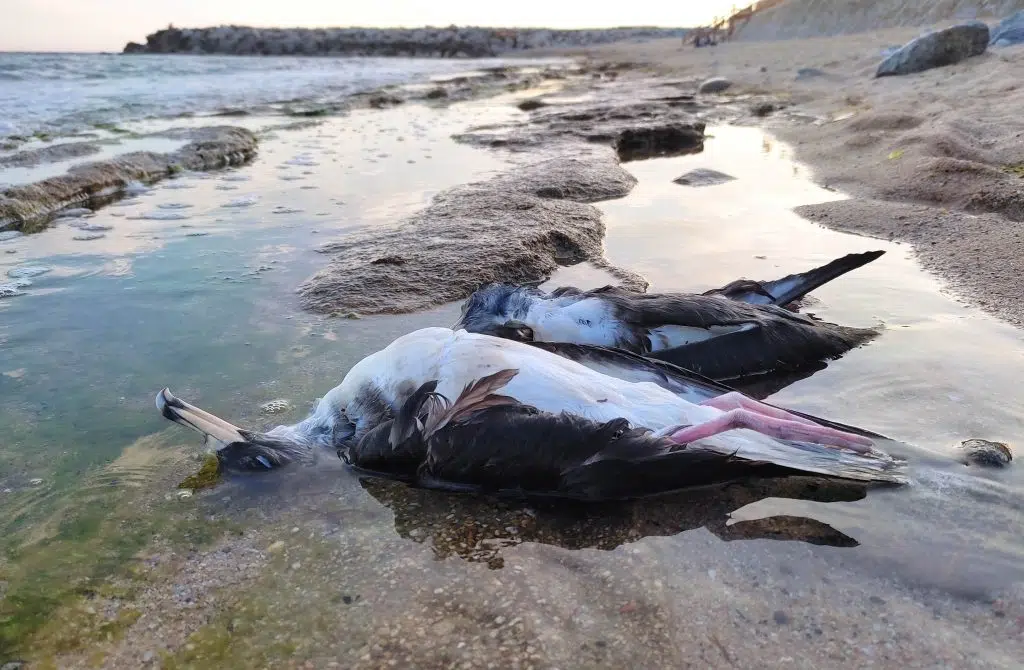Bycatch tragedy: we are losing 200,000 seabirds annually!

New study shows the real scale of seabird bycatch in European waters.
A new scientific paper co-authored by BirdLife and Partners[1] finds that nearly 200,000 seabirds die annually as bycatch in European waters – including 150,000 in EU waters. Among these, six seabird species threatened by extinction in the region are frequently recorded as bycatch. Whilst shocking, these figures paint only a partial picture. The true scale of this tragic loss could be much higher. In this study, bycatch estimates were nonexistent for more than a third of the coastal states studied, and available estimates rarely included the entirety of a country’s fishing fleet.
Seabirds are one of the most threatened groups of birds in Europe with more than a third of the species suffering from population declines. They face a range of threats at their terrestrial breeding colonies (e.g., invasive species, disturbance, habitat loss) and at sea (e.g., overfishing, renewable energy infrastructure). Climate change is adding additional pressure throughout their lifecycle. But bycatch is not only one of the biggest threats to seabirds[2] it is also one of the most manageable. In many cases, relatively simple changes to fishing practices or modifications to fishing gear can significantly reduce the number of birds that end up as bycatch in fishing gear.
“We hope this review can help researchers, fisheries managers, Governments and many other relevant marine stakeholders to understand the scale of seabird bycatch in Europe. The numbers are alarming and confirm seabird bycatch is a top threat to the migratory seabirds that breed or visit European waters. The good news is that addressing seabird bycatch is possible, and systematic monitoring and effective implementation of mitigation methods have proved to be very effective to reduce this threat,” says Iván Ramírez, co-author of the report, about the importance of the paper.
The highest levels of seabird bycatch are reported in gillnets in the Baltic Sea and the Northeast Atlantic (>95,000 birds/year) and longlines in the Northeast Atlantic and Mediterranean (>80,000 birds/year). Nearly 36,000 seabirds/year are estimated to be bycaught by the Gran Sol longline fishery for hake that operates off the coast of Scotland down to southwest Ireland. The fishery was identified as problematic back in 2011[3].
Available bycatch information mostly comes from short-term, non-regular, data collection initiatives. The absence of long-term and systematic data collection systems results in large knowledge gaps, yet anecdotal evidence indicates that seabird bycatch is occurring in areas in which data is currently lacking.
“There is a need for governments to establish appropriate monitoring systems to address data gaps and improve available information on bycatch, however, this shouldn’t detract from the priority of applying measures to reduce seabird bycatch in areas and fishing gear that are already known to be problematic,” urges Daniel Mitchel, Marine Manager at Birdlife Europe and Central Asia.
Fisheries monitoring programmes typically focus on collecting data on target species, while fisheries managers don’t pay enough attention to the wider impacts, such as the occurrence of bycatch of both target and non-target species. The International Council for the Exploration of the Sea (ICES) recently published advice on establishing appropriate bycatch monitoring systems[4] and the General Fisheries Commission for the Mediterranean (GFCM) has published a methodology for data collection on bycatch of vulnerable species[5].
Fisheries managers should utilize these resources to ensure that the collected data provides accurate and reliable estimates of bycatch and can inform actions to minimize bycatch levels. Similarly, the Agreement on the Conservation of Albatrosses and Petrels (ACAP), a multilateral agreement signed under the umbrella of the Convention on the Conservation of Migratory Species of Wild Animals (CMS) has published detailed guidance on seabird bycatch mitigation techniques.
Despite political commitments to address the problem of seabird bycatch, such as the International Plan of Action for reducing incidental catch of seabirds in longline fisheries (IPOA-SEABIRDS)[6], progress in tackling the issue on the water has been slow. In the EU, the adoption of the voluntary Action Plan for reducing incidental catches of seabirds in fishing gears[7] in 2012 was seen as a positive step, but a lack of implementation hindered its impact.[8]
“Fishers don’t want to catch seabirds and other vulnerable marine species in their fishing gear. Many are already taking action to prevent this. Fisheries managers need to set the right conditions to facilitate these efforts and require other fishers to follow their lead,” reminds Antonio Vulcano, Marine Officer at Birdlife Europe and Central Asia.
The finding of this paper should act as a wake-up call for fisheries managers that they can no longer ignore. Collaboration between fishers, fisheries managers, scientists, and civil society is vital to tackle solvable problem provided the political willingness exists to do so. Seabird bycatch is a conservation success story waiting to happen and all stakeholders have an important part to play to achieve it.
Article written by Daniel Mitchel
Cover picture: Pep Arcos
[1] The papers’ coauthors include colleagues from BirdLife Europe and Central Asia, BirdLife International, SEO/BirdLIfe (Spain), SPEA (Portugal), NABU (Germany) and LOD (Lithuania).
[2] Dias et. al. 2019 Threats to seabirds: A global assessment
[3] Anderson et. al. 2011 Global seabird bycatch in longline fisheries
[4] ICES Advice on appropriate bycatch monitoring systems
[5] Monitoring incidental catch of vulnerable species in Mediterranean and Black Sea fisheries: Methodology for data collection
[6] International Plan of Action for reducing incidental catch of seabirds in longline fisheries
[7] EU Action Plan for reducing incidental catches of seabirds in fishing gears
[8] BirdLife Europe & Central Asia, Off the Hook? Reducing seabird bycatch in the EU
Read the full Scientific paper now: https://doi.org/10.1111/acv.12948
You might as well be interested in:
 | Stichting BirdLife Europe gratefully acknowledges financial support from the European Commission. All content and opinions expressed on these pages are solely those of Stichting BirdLife Europe. The European Commission is not responsible for any use that may be made of the information it contains. |









